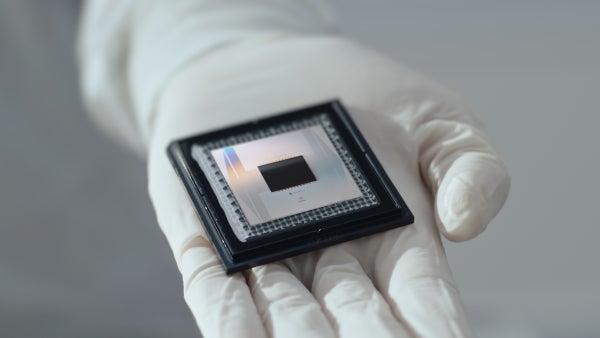October 22, 2025
4 min read
Google Explores Quantum Chaos on Its Most Powerful Quantum Computer Chip
“Quantum echoes” rippling through Google’s quantum computer chip Willow could lead to advances in molecular chemistry and the physics of black holes

Google’s Willow quantum computer chip.
Quantum computers are still in their infancy. Presently limited to 100 or so error-prone qubits, the quantum equivalents to classical bits, they are far from supreme calculating machines that are capable of exactly simulating chemical reactions and more. Quantum theorists and experimenters are working within these constraints to find feasible tasks for their devices to show an advantage over the performance of classical computers.
Researchers at Google have spent years developing one such task: measuring how quantum information gets jumbled up over time. Quantum information—such as the state of a qubit—can become spread out and disordered, a little like how a shouted word becomes indistinct as it travels over long distances.
“Different systems scramble things in different ways,” says Shenglong Xu, a quantum information theorist at Texas A&M University, who was not involved with the Google research. “How the information gets processed tells us about the nature of the system.” Insight from scrambling could even provide details that would allow quantum technologists to achieve precise molecular simulations with their machines.
On supporting science journalism
If you’re enjoying this article, consider supporting our award-winning journalism by subscribing. By purchasing a subscription you are helping to ensure the future of impactful stories about the discoveries and ideas shaping our world today.
In a preprint paper, posted online in June, the Google team reported the most in-depth measurement of information scrambling to date, which was achieved with their 105-qubit Willow chip. They repeatedly scrambled the information, made a small adjustment and reversed the process, unscrambling the information. (Google dubbed the protocol “Quantum Echoes,” a reference to the echo of the repetitive unscrambling process.) The team’s measurement was so complex, in fact, that using current algorithms a classical supercomputer would be far slower than Willow. The results were published today in the journal Nature.
The Nature paper’s three referees were broadly positive about the technical accomplishment in anonymized peer review reports that Google shared with Scientific American. One of these reviewers praised the work as “truly impressive” for “experimentally accessing such subtle quantum interference effects.” But the referees split over the degree to which Google had demonstrated bona fide quantum advantage.
Previous demonstrations of quantum advantage have been surpassed as classical algorithms have improved, so onlookers are cautious. The Google team’s achievement “seems like it is beyond what we can do right now using classical methods,” Xu says. “It’s a very interesting contribution to the field.”
Float like a Qubit
Chaos is common to the classical world because classical systems can be highly sensitive to small changes in their initial conditions. In the canonical metaphorical example, a butterfly flaps its wings in Brazil, and the cascading sequence of atmospheric perturbations leads to a tornado in Texas.
So what happens to the proverbial butterfly in a quantum system? “There’s always going to be small [quantum] fluctuations,” says Pieter Claeys, a physicist at the Max Planck Institute for the Physics of Complex Systems in Dresden, Germany, who was not involved with the new study. Like the classical butterfly, these fluctuations can also have downstream effects on the scrambling of information in a quantum system.
To study how quantum information gets scrambled, researchers use an unscrambling trick called an out-of-time-order correlator (OTOC). The OTOC protocol goes something like this: take a solved Rubik’s cube and scramble it with a set sequence of twists. Then add an additional twist and perform the first sequence in reverse. The first and last processes—the scrambling and unscrambling—effectively cancel out letting you examine the effects of the twist in the middle, appropriately called the “butterfly operator.” (This is sometimes misleadingly referred to as “time reversal.” Time does not really reverse itself in this process any more than it does when you say the alphabet backward.)
In 2021 Google demonstrated the OTOC protocol on its Sycamore chip—a more error-prone, 53-qubit predecessor to Willow. In a press call discussing the new Willow results, Hartmut Neven, head of Google’s quantum computing effort, described OTOCs as a “measure of how quickly information travels in a highly entangled system.” In their 2021 work, the Google researchers were able to observe in detail how information spread across Sycamore’s grid of qubits, rippling outward from an initial state. While intriguing, the result was well within the reach of classical supercomputers.
To test the limits of Willow, with its doubled number of qubits and roughly doubled qubit fidelity, the Google researchers ran it through a doubled OTOC protocol: scramble, butterfly, unscramble, scramble, butterfly, unscramble. In the Rubik’s cube analogy, these doubled steps made the measurement’s complexity much higher. At the same time, as it reduced the overall detectability of the butterfly in the scrambled system, the complexity made the measurement far more difficult for classical computers to simulate. Google researchers estimate it would take three years for a classical supercomputer to do what Willow did in two hours. Some peer reviewers urged caution. As noted, numerous claims of quantum advantage—including one from Google in 2019—have fallen apart as classical algorithms have improved.
At the end of the Nature paper, the Google researchers teased that the “exciting real-world application” of using OTOC for molecular simulations would appear in future work.
Today the Google team began fulfilling that promise, releasing the first steps of its process in another preprint. The researchers applied an OTOC protocol to Willow to estimate a key property of a system of organic molecules: the distance between two hydrogen atoms. Though the simulation technique is still nascent and not faster than classical approaches, it does seem to agree with experimental results.
The practical applications of quantum mechanically precise chemistry are not the only intriguing aspects of the latest result. Physicists such as Xu are curious about what doubled or tripled OTOC protocols can say about information scrambling.
OTOCs might even be a clue to a mystery at the heart of physics: What happens to information inside a black hole? “People have started thinking about information scrambling and information dynamics in the context of black hole physics,” says Laura Cui, a Ph.D. student researching quantum information at the California Institute of Technology. “We’re very much on the way to resolving it using these tools from information theory.”
It’s Time to Stand Up for Science
If you enjoyed this article, I’d like to ask for your support. Scientific American has served as an advocate for science and industry for 180 years, and right now may be the most critical moment in that two-century history.
I’ve been a Scientific American subscriber since I was 12 years old, and it helped shape the way I look at the world. SciAm always educates and delights me, and inspires a sense of awe for our vast, beautiful universe. I hope it does that for you, too.
If you subscribe to Scientific American, you help ensure that our coverage is centered on meaningful research and discovery; that we have the resources to report on the decisions that threaten labs across the U.S.; and that we support both budding and working scientists at a time when the value of science itself too often goes unrecognized.
In return, you get essential news, captivating podcasts, brilliant infographics, can’t-miss newsletters, must-watch videos, challenging games, and the science world’s best writing and reporting. You can even gift someone a subscription.
There has never been a more important time for us to stand up and show why science matters. I hope you’ll support us in that mission.









